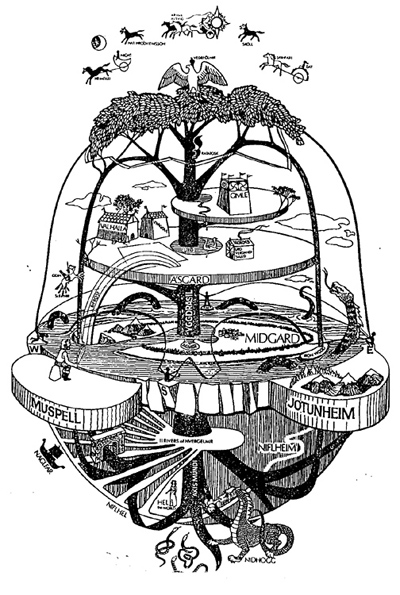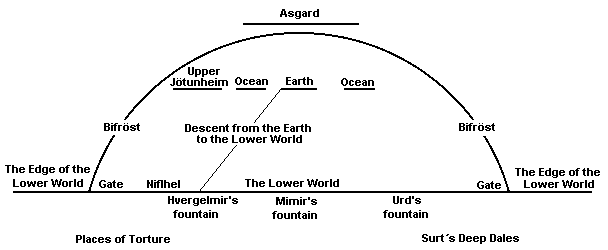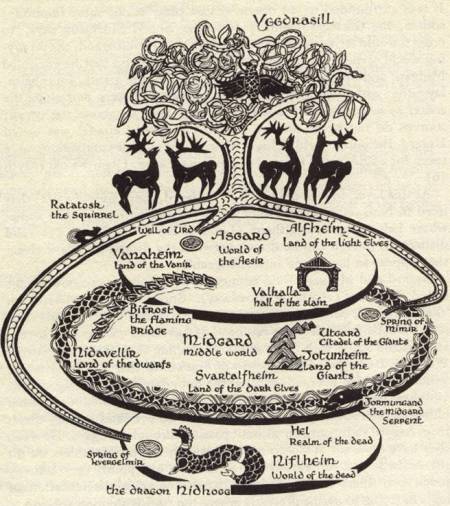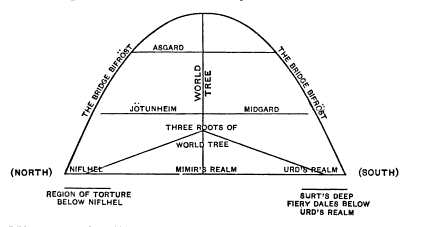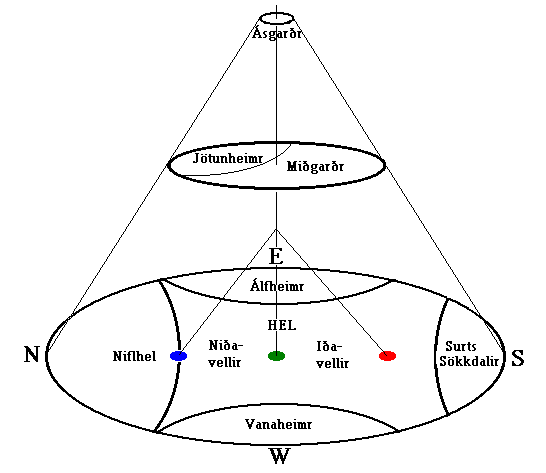|
The Nine Worlds
of Norse Mythology |
|
"I recall nine homes..." níu man ek heima
The designation "Nine Worlds" is a well-known staple of Old Norse mythology, but what are the nine worlds exactly? Can anyone name all nine? Where are they located? These are natural questions.
*íviðjur, "wood giantesses", also known in the singluar from Hrafnagaldur Odins 1, where it seems to refer to the Old One in the Ironwood, breeding Fenrir's kin (Voluspa R39-40), perhaps referring here to Heimdal's nine mothers. (Larrington), or nine wooden spindles, or 9 types of wood, used to kindle friction-fire on a wheel (the world-mill), as described by Jacob Grimm in Deutsche Mythologie s.v. need-fire. In the epic system, Heimdall appears to represent the Tree and the holy fire at the same time.
Mjötvíðr, the Measuring Tree, is commonly understood to be the world-tree, Yggdrassil, so-named in Völuspá 20. Yet the nine worlds are nowhere enumerated. Exactly what the völva means when she says 'nine worlds' here is never clarified. There is no master-list of the 9 worlds.
To complicate matters, not only are there nine worlds,
according to the Eddas,
but also twelve heavens. Snorri provides us a list of 12 heavens
in Skáldskaparmál 69. Of these, Snorri informs us that Vidblainn and Andlang
are the heavens of the higher
worlds:
Nine Worlds— the concept is easy
enough to grasp. The universe consists of nine homes or "worlds", each
primarily inhabited or ruled by a unique tribe of beings. The names of at least a few of the
worlds probably have already sprung to mind.
Although several illustrations of Yggdrassil have been published, these 4 works contain the primary representative efforts to create a list of the nine worlds. Similar lists appear with little or no variation. Looking at their similarities and differences may help determine the actual meaning of the phrase "the nine worlds." All 4 of these lists share the following worlds in common:
Only the first four are found in the poems of the Elder Edda. The fifth is unique to Snorri's Edda. The following worlds, common to all of the lists, appear in variant forms, suggesting some confusion regarding the exact form of the name:
Of these Muspelheim (and its
variants) is unique to Snorri's Edda, and does not appear
anywhere in the poems
of the Elder Edda or skaldic poetry. And while Álfheim appears as a place-name in
the Elder Edda, Ljósálfheim does not appear in either the Elder
or the Younger Edda. It is a term invented and promoted by modern scholars,
to distinguish it from Svartalfheim (a placename
found only in Snorri's Edda), no doubt.
Note too that while the first 3 scholars list Niflheim and Hel (or Helheim, a name not found in the lore) as distinct worlds, the final list suggests that there is some confusion in the modern popular imagination whether Hel and Niflheim are alternate names for the same world. The map of Yggdrassil published by Marvel Comics presents Hel and Niflheim (sic Niffleheim) as one world— the world of death— and adds Nidavellir as another world to round out the nine. Other popular cosmological maps present Hel and Niflheim as one world, as conjoined realms, and as independent worlds. Those that combine the two realms sometimes add Nidavellir, a place name found in Völuspá, as a separate world. Below I will examine the reasons for and implications of these choices. Before doing so, I just want to point out that in addition to "the nine homes" in the Tree, Vafþrúðnismál speaks of "nine homes" located below Niflhel, which itself is identified as the lowest or "ninth" world. The poem Vafþrúdnismál specifically speaks of "nine worlds" below Niflhel. These are distinct from the "nine worlds" in the Tree:
Vafthrudnir
"Frá jötna
rúnum ek kann
segja satt, ek heim of
komit; helju
halir."
Vafthrudnir
43. Of
the runes of Jötuns
and all
gods, I can truly
tell; for I have
travelled over each
world; to nine
worlds I came, down below
Niflhel; here die
men from Hel.
Notice in the verse above that the world known as Hel is distinguished from Niflhel. Men "die from Hel" into Niflhel. It's a second death, most likely for the worst of sinners. From Völuspá 38-39 we know that terrible punishments await those who transgress the heathen moral code in a land "far from the sun" known as the ná-strands (the corpse-beaches). There condemned men wade in venom inside a hall braided from serpents' backs. Völuspá 39 informs us that the dragon Niddhögg tarries there eating nair (corpses). In agreement with this, Grímnismál 34 says many serpents lie below Yggdrasill, and the following verse adds that Nidhögg rends Yggdrasill from beneath. Völuspá informs us that the doors of this hall face north, and a passage in Saxo Grammaticus' Danish History, book 8, tell us that this hall can be reached by sailing due north from Denmark, across dark waters, leaving the sun behind.
Other passages in the Poetic Edda also support this separation. In Baldurs Draumar, Odin rides "to Niflhel", and once there, as he continues to ride, apparently toward the border between these two realms, since in Niflhel he sees a dog with a bloody breast, "coming out of Hel". Long it howled at the father of spells, as he rode further to "Hel's high hall". The ground now "thunders" (v. 10) beneath the weight of a living rider, just as it did when Hermod crossed this same way on Sleipnir, Odin's own horse (Gylfaginning 49).
We cannot be certain if the use of the word Hel in the
last line (hávu Hels ranni) is a a personal name or a
place name— in other words, we don't know whether the hall
belongs to Hel or simply is found in Hel. One thing is certian,
however, the description of the hall in the following verses, as
an opulent, well-adorned hall with sparkling mead served in
goblets prepared for Baldur's arrival stands in stark contrast
to the hall of Loki's daughter, whom Snorri names "Hel" in
Gylfaginning 37. In
Gylfaginning 3, Snorri also distinquishes between the worlds of Hel and
Niflhel, and identifies Niflhel as "the ninth world":
"Hitt er þó mest, er hann gerði manninn ok gaf honum önd
þá, er lifa skal ok aldri týnast, þótt líkaminn fúni at moldu
eða brenni at ösku, ok skulu allir menn lifa, þeir er rétt eru
siðaðir, ok vera með honum sjálfum þar sem heitir Gimlé eða
Vingólf, en vándir menn fara til Heljar ok þaðan í Niflhel. Þat
er niðr í inn níunda heim."
What is most important, he (God) made man and gave him a
spirit, which shall live, and never perish, though the body may
turn to dust or burn to ashes. All who live a life of virtue
shall dwell with him in Gimli or Vingolf. The wicked, on the
other hand, go to Hel, and from there to Niflhel, that is, down
into the ninth world.
Elsewhere,
Snorri states that Loki's half-livid daughter, whom he names Hel, was given power over
"nine worlds" after she was thrown into "Niflheim" by Odin. In Gylfaginning 34,
he writes:
Hel
kastaði hann í Niflheim ok gaf henni vald yfir níu heimum, at
hon skyldi skipta öllum vistum með þeim, er til hennar váru
sendir, en þat eru sóttdauðir menn ok ellidauðir.
Hel
he cast into Niflheim, and gave her power over nine worlds,
to apportion all abodes among those that were sent to her: that
is, men dead of sickness or of old age. She has
great possessions there; her walls are exceeding high and her
gates great. Her hall is called Sleet-Cold; her dish, Hunger;
Famine is her knife; Idler, her thrall; Sloven, her maidservant;
Pit of Stumbling, her threshold, by which one enters; Disease,
her bed; Gleaming Bale, her bed-hangings. She is half blue-black
and half flesh-color (by which she is easily recognized), and
very lowering and fierce.
This description of Hel's hall, the abode of Loki's daughter, is the exact opposite of hávu heljar ranni, the "high hall of Hel", seen by Odin in Baldurs Draumar:
Instead of a plate of hunger and a knife of famine in a dreary hall, Odin sees a rich feast spread for his beloved son. Loki's daughter is nowhere to be found. Arguably, she does not appear in the poems of the Elder Edda.
The place-name Niflheim is unique to Snorri's work. The older Eddic poems instead use the term Niflhel. So, Niflhel, is most likely the same as Snorri's Niflheim, and one of the nine worlds. As shown above, he uses the terms interchangably. Being distinct from it, Hel is most likely another world. Niflhel appears to be a world especially for the wicked dead (adulterers, murderers, and seducers of other men's wives, and their ilk), leaving the world Hel for the remaining dead, not worthy of ascending to Valhalla. According to Vafþrúðnismál, men die "out of Hel" into "Niflhel". The passage from Hel to Niflhel is thus equivilent to the passage from Midgard, the world of living men, into Hel. It constitutes a second death.
In the poems of the Poetic Edda, the word Hel is a place-name referring to the land of the dead, distinct from Niflhel. In Snorri's Edda, Hel is the personal name of Loki's daughter, a terrible being best fit to rule over Niflhel. Snorri calls her realm Niflheim. This explains the confusion among scholars regarding the names and natures of these worlds.
In Gylfaginning 4, Snorri introduces Niflheim as one of two opposing elemental worlds, existing before the creation of the ordered universe:
Before Odin and his brothers arranged the created worlds, Niflheim, the primordial northern world of ice, was the natural home of the ancient frost-giants. Surt ruled over a southern world of fire.
In Skirnismál 25, after Gerd refuses to accept 11 golden apples and the ring Draupnir, burned on Baldur's breast, Skirnir draws his sword, the blade he got from Frey, and threatens to dispatch the giant maid to the underworld. There, Skirnir says, she will dwell among hrim-thursar ("frost-giants"), joyless and subject to "endless horrors" (v. 30). This place is so horrible, he predicts, she will climb a mountain each morning and look toward Hel (v. 27), but there will be no escape. Naturally this place is identical to Niflheim, the home of the ancient frost-giants.
Skirnir elaborates on the threat. After he kills her with the sword, instead of a bliss-filled life with the lord of harvests, Gerd will be wed to a three-headed thurs (31 cp. 35), but she will never know a man's pleasure (v. 34) for like Ymir, these giants reproduce asexually. Under Ymir's arm, a man and maid sprang together; and together his feet begot a three-headed son. To underscore this point, Skirnir threatens to carve for Gerd the runes thurs, ergi and othala (cold-heartedness, sexual deviancy, and burning lust). She finally relents to his threats and agrees to meet Frey.
Taken together, these statements paint Niflhel (or Niflheim) as a dismal place inhabited by monsters and dead men. Snorri confirms this view in his Edda. He calls the primordial world of ice Niflheim. This appears to be the same realm that the Poetic Edda designates as Niflhel, after the creation of the nine worlds. Thus, before Odin and his brothers created the worlds, there existed a world of ice to the north and a brilliant world of fire to the south, later guarded by Surt (Soot, Black). Between them yawned a great abyss called Ginnungagap, into which the rivers of Niflheim flowed.
The primary evidence for a world of fire to the
south is found in
Gylfaginning 6:
This place —Múspell or Múspellsheim— is the home of Surt.
Like Niflheim, the place-names for the southern world of
fire are not found in documents older than Snorri's text.
Still, we find evidence for its existence in the Poetic
Edda. Völuspá 52 states:
As one of the first worlds, Surt's homeland must now be at the very base of the created world structure— i.e. "buried" under the subsequent created worlds. As a foundational world, it lurks at the base of the pyramid. For this reason, the heathen skald Eyvind refers to it as Surts sökkdalir, Surt's sunken-dales. It is located in the deep south.
As shown above, the spring Hvergelmir, which waters the northern root of Yggdrassil, flows out of Niflheim into Ginnungagap. To the south of the great abyss, we find Surt's home. In a verse by the newly-coverted Christian skald Eilífr Guðrúnarson preserved in Skáldskaparmál 65, Christ is said to sit in the judgment seats of the old heathen gods "south at Urd's well" (sunnr at Urðarbrunni). Thus, it would seem that Urd's warm well, in which swans swim, is located in the same direction as Surt's fiery homeland. When Mimir's well Oðrerir, which lies "where Ginnungagap once was" (Gylfaginning 9) is threatened by the "mightest winter" (mestum þorra), Urd is appointed its protector (Hrafnagaldur Óðins 2) The southern position of Urd's well can be confirmed in another way.
Grímnismál 29 warns us why Thor cannot cross over the Bifröst bridge to join the other gods in their daily journey to Urd's well.
Should he try to cross Bifröst in his goat-drawn chariot, the bridge would burn and the holy waters (or Urd's well) would boil. Haustlöng's account of Thor's chariot in flight provides a vivid explanation of why this is true:
In motion, Thor's chariot causes the sky to burn and the ground below to tremble. Thus, it can only be ridden through wide-open spaces. If Thor attempted to drive his fiery chariot across Bifröst, the delicate span would burn and break.
At Ragnarök, we see that this is precisely what happens. When Surt arrives from "the south" with the "bane of branches" [fire]. His men ride with him, and the rainbow bridge breaks under the weight of riders, causing the horses to swim in the stream. Fáfnismál 15 says:
Bilröst brotnar,
Grimnismal 21 tells us that this stream is too rapid for the battle-slain to wade, thus they need the steady road of "Throdvitnir's fish" (Heimdall's bridge, Bifröst):
Þýtr Þund,
*Þjóð-vitnir = "the one with mighty senses" [i.e. Heimdall]; the phrase is usually translated as "the mighty wolf" and scholars have struggled to understand its meaning. The word vitnir, "wolf", however, literally means "one with sharp senses" [see Sveinbjörn Egilsson's Lexicon Poeticum vitnir= ulv egl 'med (skarpe) sanser': wolf literally 'with (sharp) senses']
fiskr = metaphorically "a bridge", since a bridgehead is called a brúar-sporðr, "bridge's fish-tail."
Many modern scholars equate Surt's men with Muspel's Sons. This because, Snorri tells us that
they arrive together, through a hole in the sky in Gylfaginning
51. Snorri equates them with the "light-elves" who live in
Gimli! But in Völuspá 51-52,
we find that "Muspel's sons arrive with Loki from the east",
while "Surt arrives with the bane-of-branches ['fire'] from the
south." In contrast to this in Gylfaginning 51, Snorri says that Muspel's sons arrive with Surt, riding through a crack in the sky. In Gylfaginning 5, he calls the southern world of fire, variously: Múspell, Múspellsheim ('Muspel's world') and Múspellheim ('Home of Muspel'), as if he was unable to decide on a name for it. According to his own usage, Múspell seems to be the name of a giant whom some scholars identify with Surt. In Gylfaginning 43, Snorri says of the ship Naglfari, built of deadmen's nails, that "Muspel has it". [En Naglfar er mest skip. Þat á Múspell.] This ship best belongs in Niflhel.
In Gylfaginning 51, it's almost as if Snorri portrays Surt and his men as Christian angels of light who have come to destroy worship of the old pagan gods. Considering the Christian thrust of both the Formáli (Prologue) and Gylfaginning, this may have been Snorri's purpose at the final chapter of Gylfaginning. It cannot, however, have been the intent of the heathen poet who composed Völuspá.
Remarkably, this interpretation, based on a literal
reading of Snorri's text, led some of the earliest modern
scholars to
place Muspelheim above Asgard and to
identify Muspel's sons with the light-elves! As an older and more
reliable source of heathen mythology, Völuspá
says:
We find evidence in Lokasenna 42
and in a German poem titled Múspelli that
the word múspell
is an ancient Germanic word associated with the end times.
Nevertheless, the place-name(s) Múspell, Múspellsheim and Múspellheim are
unique to Snorri's text and may simply be a back-formation of the
tribal names muspels lýðar and muspels sonar, "Muspel's people"
and "Muspell's sons" found in the Poetic Edda. Their
designations are
sometimes translated as
"sons (or people) of Destruction". In the Poetic Edda,
the term "Muspel's sons" seem to refer to the packs of
werewolves born of "the old one in the Iron wood" (Völuspá 40)
by Fenrir, Loki's son. They are "Fenrir's
children," wolves. Loki himself brings them to the battlefield by
ship "from the east" to meet the Aesir. In contrast, Surt and his followers arrive over
Bifröst from the south. Snorri's identification of Surt's men with the Light-elves is found in Gylfaginning 17. There Snorri provides more information about the homes of the Light-elves and the Dark-elves. He doesn't use the terms Ljósalfaheim (Light-elf Home) and Svartalfaheim (Black-elf Home) however. Snorri simply says that Light-elves live in Alfheim, and that Dark-elves live below ground. He writes:
The
placename Ljósálfaheim
never occurs in the lore. It is a term invented by and carried forward by modern scholars
(beginning with Finnur Jónsson, see below), based on
the term Svartálfaheim found several times in Snorri's Edda. I
shall discuss Snorri's use of the term Svartálfaheim, as the
home of dwarves, below (see "The Last World— Svartálfaheim?")
The idea
that Surt's realm "Muspellheim" and Alfheim are higher worlds clearly comes from
Gylfaginning 54's account of the battle of Ragnarök. Here, the
Sons of Muspel arrive with Surt after the sky is rent in two
(inspired by Völuspá 52). As Finnur Magnússon (1825) and Gustav
Legis (1829) illustrate, Snorri's text seems to place
Muspellheim and Alfheim above Asgard. Accordingly Snorri
says that Surt and Muspel's sons ride together through the crack
in the sky, presumably downward from above.
This contradicts the testimony of Völuspá, which Snorri cites as
evidence of his own correctness!
Gylfaginning 54:
In an apparent attempt to
reconcile his work with Völuspá, Snorri tells us that Gimli
is located in the southern portion of heaven.
Comparing this to his citation of Völuspá, however, we see
that only Surt arrives from the south (verse 52); while in
verse 51, Muspel's sons arrive with Loki from the east.
Völuspá 64 gives no direction for Gimli.
Snorri's understanding of Völuspá's Ragnarök sequence calls into question his name for the southern world of fire. There is no reason to call it Múspel, Múspellsheim or Múspellheim, if Muspel's sons do not dwell there. As noted before, in the poetic sources, the southern world of fire is simply called Surts sökkdalir, "Surt's sunken-dales." And, as shown above, we can safely do away with Ljósalfaheim. Instead we have Alfheim.
In Gylfaginning 17, Snorri informs us that only Light-elves live in Álfheim. Dark-elves he says abide beneath the earth. He does not use the modern term Ljósálfaheim to designate their home. As confirmation, we also find Álfheim as a place-name in older poetry. It occurs once in the Poetic Edda in Grímnismál 5. The preceding verse, Grímnismál 4, informs us that Thrudheim, Thor's home in Asgard, lies closest to the Æsir and the Alfar:
When Thor travels from Asgard to meet the giant Hymir in
Jötunheim,
Hymiskviða 7
(cp.
38) gives us some sense of direction:
Fóru
drjúgum
dag
þann fram
Ásgarði
frá,
unz
til Egils kvámu;
hirði
hann hafra
horngöfgasta;
hurfu
at höllu,
er
Hymir átti.
On the way from Asgard (located 'up' in the sky) to Jötunheim ('in the east'), Thor stops
and leaves his goat-team and chariot at the home of a person
named Egill. The exact location of Egill the goat-keep’s, house is not stated in the
surviving lore. However, the available clues provide some
indication of where it was thought to be. When Thor leaves his goat-team
behind, safe at Egill's, he heads east on foot toward Hymir's
hall. Hymir, we are told, lives “east of the Elivagor” at “the
edge of heaven.”
(Hymiskviða 5/1-4).
If Hymir's
home is 'east of the Elivagor' (Ice-waves) and we know that Thor
regularly crosses a body of water to enter Jötunheim then Egill's
must be west of these same waters, on the opposite shore as
Jötunheim, on the Midgard-side of the boundary waters. In the Poetic Edda, the only other Egill we find is the brother of the famous smith Völund. In Völundarkviða, Völund and Egil are "elf-princes" and "sons of a Finnish king". In fact, the Lapps (Saami) are often equated with the elves in the Icelandic sources. Geographically, Finland is north-east of Scandinavia, and continuing the same direction one encounters the Arctic Ocean. The mythic worlds of Jötunheim and Niflhel lie to the east and to the north respectively. Both lands are inhabited by giants hostile to the gods. Once in Jötunheim, Thor and Hymir fish for the Midgard serpent. The Snake circles the known world biting its own tail. His home is the great river which rings the world. Thor crossed these waters to reach Hymir's, and will flee over them with Hymir's kettle when he leaves. His belt of strength gives him the power to "grow as high as heaven" so that he may wade these waters safely. (See Ásmegin: Thor's Might and the Belt of Strength)
In Hymiskviða, Thor leaves his goats on the opposite
shore, safe with Egill in Álfheim before crossing over with Tyr,
then he and the giant venture out on the same waters to fish for
the Midgard Serpent. Thus, its head and tail were thought
to lie in the northern Arctic waters. In a poetic metaphor found
in
Þórsdrápa 5,
these waters are said to be as cold as venom.
in Skáldskaparmál 25, when Thor carries his friend Aurvandill
across these waters in a basket on his back, one of his toes is
left exposed to the venomous liquid. As a result, the toe turns
black from frost-bite. Thor breaks it off and makes a star of
it. Völuspá informs us that at Ragnarök, Thor will succomb to this
same venom, stepping back nine paces before falling. Grímnismál 4 informs us that Thor's home Thrudheim lies closest to the land of the Aesir and the Alfar. Egill, the "peasant" (bondi) who keeps his goats, is an elf-prince and the son of a Finnish king according to Völundarkviða. In Hymiskviða 37 (cp. Gylfaginning 44), we discover that Egill's home is where Thor gained his servant Thjálfi, whose very name contains the word alf. For this reason, he is often identified as such in modern scholarship.
From the available evidence, Alfheim seems to
be a way-station for Thor on his journey from Asgard to Jötunheim.
Thor leaves his goat-car there and enters the land of giants on
foot, first crossing a great body of water. It should come as no
surprise then that Váfthrúðnismál 16 speaks of boundary waters
located between Jötunheim and Asgard. "Ífing heitir á, 16. That
river is called Ifing
That
cuts off the land
Of
the giants’ sons
From
the gods;
It
runs open throughout all time.
On
that river no ice forms.
In
Hymiskviða, it is apparent that Hymir lives near the
'river' that circles Midgard. We know this, because he and Thor
go fishing on it, and Thor catches the Midgard Serpent in its
waters. Therefore, it is probable that Elivagor ('Icy-waves') is
another name of Ifing, the river that rings the world. It is
bitter-cold, but never freezes over. Like all
mythic things, it is known by more than one name. This river is
the Arctic ocean. Jötunheim lies beyond its waters (within the
Arctic Circle). From there, the way to Niflhel is "north and
down".
In Saxo Book 8, the adventurer Thorkill
arrives there by ship, sailing due north into the murky
darkness, leaving the sun and stars behind. In real world
geography, these turbulent icy waters were known as The White
Sea, and as Gandvik, the 'Magic-bay'.
In
Váfthrúðnismál 16, we discover that at Ragnarök,
the sea-god
Njörd will return to his homeland Vanaheim, westward across the sea. Óðinn kvað:
Gagnrad
38. Tell me tenthly,
since thou all the origin
of the gods knowest, Vafthrudnir!
whence
Niörd came
among the Æsir´s sons?
O’er fanes and offer-steads
he rules by hundreds,
yet was not among the Æsir born.
Vafthrudnir
39. In Vanaheim
wise powers him created,
and to the gods a hostage gave.
At the world’s dissolution
he will return
to the wise Vanir. Because the Vanir are a tribe of gods akin to the Æsir, Vanaheim is typically placed alongside Asgard in the heavens. However, it is probably best placed across the western sea from Midgard, opposite from Jötunheim. Perhaps related to this, Baldrs Draumr 11 informs us that "Rind bore Vali," Baldur's avenger, "in western halls." In contrast, Odin's avenger, Vidar is born to the giantess Grid, who lives in the east. Sixth, Seventh and Eighth Worlds
I believe that the evidence for Midgard, Asgard, and Jötunheim (the homes of men, gods and giants respectively) are too well established to require explanation.
Midgard, the home of Men, is found as a placename in Völuspá (4, 56), Harbarðsljóð 23, and Hyndluljóð (11, 16), as well as being attested in various forms in several later Germanic works.
In the Poetic Edda, Asgard appears as a place-name in Þrymskviða 18 and Hymiskviða 7. In the skaldic poem Sonnatorrek, preserved in Egils Saga, we are told that Goðheim ('Home of the Gods') is located above Midgard. The poet, whose son died young, expresses his hope that Odin has taken him to Valhalla, "up in Godheim" (es upp of hóf í Goðheim).
Jötunheim, the home of the Jötuns, is named in a number of Eddic poems including Völuspá (8, 48), Skírnismál 40, and Þrymskviða (7, 12, 13, 20, 21, 26, 28). Occassionally, some illustrations of Yggdrassil will include Utgard, a place-name found in Gylfaginning, either as a separate world or as a city in Jötunheim. For example, the map of Yggdrassil in Kevin Crossley-Holland's The Norse Myths (1988) lists Utgard as "a citadel of the giants" in the world of Jötunheim. Yet, he lists Asgard as "the world of the gods." Using the logic applied to Utgard, Asgard might best be described as a "citadel of the Æsir" located in the world called Goðheim.
Based on evidence found in the tale of Utgard-Loki as told by Snorri in Gylfaginning 45 and 46 and references to the same myth in Harbarðsljóð 26 (compared to Hávamál 12 and 104-110), Utgard is best understood as another name for Surts sökkdalir, the southern world of fire. Utgard-Loki appears to be the fire-giant Suttung, also called Fjalar. He commands Logi (wildfire) and is a master of "eye-spells" (heat mirages). The fire that consumes the world at Ragnarök is known as Surtarlogi, Surt's wildfire, and the name Suttung may be interpreted as a condensed form of Surts ungr, Surt's son. Surts sökkdalir is the only name the old poems give us for the fiery realm that Snorri calls Muspell. Snorri calls this same place Utgard later in Gylfaginning.
For reasons that are unclear to me, some accounts of the nine worlds in modern scholarship identify Utgard as the underworld. In regard to location, I would tend to agree, placing it directly below Hel, not for the same reasons, but rather for those which I have already given above. As one of the primoridal worlds, "Surt's sunken dales" lies at the very base of the created worlds. When he destroys the upper worlds with fire at Ragnarök, his flames burn up the created worlds, leaving the lower world (the original plain) as a "new earth" in its place. Thus, the fields that the gods tread upon in their youth (Idavellir, Völuspá 7) are found again in the "new" world (Völuspá 58). There the surviving Æsir find the golden game-pieces that their parents played with in the earliest days. Properly it is Mimir's realm, "where Ginnungagap once was" (Gylfaginning 9). Thus, the human survivors Lif and Lifthraisir, emerge from Hoddmimis holt, "Hoard-Mimir's grove" when the fire subsides.
So without further speculation, I think we can safely name most of the nine worlds as found in the surviving lore. In no particular order, we have: 1. Asgard
And again in Skáldskaparmál 36:
If we accept that the dark-elves (dökk-alfar) and the black-elves
(svart-alfar)
Jörmungrundar
At Jörmungrund's
Earlier in Gylfaginning 43, Snorri identifies Ivaldi's sons are dwarves:
However, using passages from the eddic poetry, we have reason to believe that Ivaldi's sons were originally conceived of as elves (Alfar). In Hrafnagaldur Odins 6, the goddess Idunn is said to be their sister.
In Grimnísmál 5, we learn that Alfheim was given to Frey upon cutting his first tooth. Thus, the elves are subject to him. Lokasenna 2 speaks of the Æsir and Álfar gathered in the hall, when Loki bursts in and insults the gathered gods. Among those seated inside we find Idunn, as well as servants of Frey named Byggvir and Beyla. Thus indeed we find Alfar (elves) mingled with the Æsir in the hall.
I suggest that Snorri's confusion between the "álfar" (elves) and "dvergr" (dwarves) was likely caused, at least in part, by the so-called dwarf-list of Völuspá, which contains the names of both dwarves and elves. This list, however, is not considered to be an original part of the poem, and is generally thought to have been interpolated with additional names by copyists.
In Gylfaginning 14, Snorri speaks of the creation of the dwarves, citing Völuspá 10 and 11 as support.
Immediately following this, Snorri begins reciting the so-called "dwarf-list" from Völuspá 11-16, a þula which includes obvious names of elves such as Álfr, Gandálfr, and Vindálfr. In the midst of this, Snorri says: "And these also are dwarves and dwell in stones, but the first in mould" (En þessir eru ok dvergar ok búa í steinum, en inir fyrri í moldu). Yet, in Gylfaginning 15, Snorri clearly distinquishes between elves and dwarves, citing a verse from the the Eddic poem Fafnismál as support:
Snorri tells us that the dwarves first grew as maggots in Ymir's flesh. Thus, Blainn (the Blue One) is likely a poetic name for Ymir, who was slain by Odin and his brothers and whose body was used as raw material to build the upper worlds. Brimir, however, seems to be associated with Mimir. As one of the oldest beings, older than Odin, Mimir must be one of the first created beings. As such, he could be a son of Ymir himself. Since Odin is the third generation from Ymir, Mimir must be among the first or second generations. The choices are limited. Vafþrúðnismál 33 says us that "a boy and a girl together" were born under Ymir's arm. As some of the first beings, Mimir and Urd may well be that boy and girl. The evidence is simply too slight to base any conclusions on.
The association between Brimir and Mimir is most apparent in Sigrdrifumál 14:
Odin also speaks with Mimir's head, just before the
battle of Ragnarök in Völuspá 45, and pawns an eye for a drink
of Mimir's well in Völuspá 28. The expression "Brimir's sword"
may be a poetic metaphor meaning "Brimir's head" as Snorri says
a head could be called "Heimdall's sword" since he was killed
with a man's head. If so, then the verse simply says that when
Odin stood on a cliff with "Brimir's sword" (i.e. Brimir's
head), then "Mimir's head" spoke to him wisely. It is not
uncommon in eddic poems to restate the same thing which appears
in the first half of the stanza using poetic metaphor, in the
second half of the stanza more plainly. As it stands Brimir's
blood is associated with Blainn's (Ymir's) limbs as components
in the creation of the dwarves, and the giant Brimir has a
beer-hall in the vicinity of a hall for dwarves. In the same
poem, Mimir is said to drink mead "every morning" from his well,
the same spring in which Odin pawned his eye. The name
Brimir is also directly associated with Mimir's head in
Sigrdrifumal 14, which speaks with Odin, as it does in Völuspá
45.
We have good reason to associate Mimir with the dwarves:
—Motsognir ('Mead-sucker',
'Mead-drinker') is said to be the foremost or master of the
dwarves in Völuspá 10, taking part in their creation.
So it's no stretch to consider Mimir's realm to be the home of the dwarves. Gylfaginning 9 tells us that Mimir's realm is located "where Ginnungagap once was." In other words, it is situated directly between the southern world of fire and the northern world of ice which existed before the creation of the upper worlds by Odin and his brothers.
Ginnungagap was the birthplace of Ymir, and the origin of all life. Here, when the sparks from the south met the ice-floes from the north, life quickened from the venomous drops, developing into Ymir and Audhumbla, the primoridal giant and the primeval cow, the source of all life. Mimir's well is located at the physical and spiritual center of all creation. As such, Yggdrassil is called Mimameiðr, 'Mimir's Tree' (Fjölsvinnsmál 24). Rising up the trunk of the tree, we find Midgard and Valhalla in Asgard as other central points along the vertical axis of the Tree. In several of the Icelandic Fornaldarsagas and in Saxo's Danish History Books 1 and 8, we encounter the giant Gudmund who is the ruler of the "Glittering-Plains" (Glæsisvellir). He is a giant and champion of the heathen faith. His is a rich, fertile country, a neighbor of the realm of the giants. Gudmund of Glæsisvellir appears to be a historic memory of the mythic Mimir, the treasure-hoarder, Odin's life-long counsellor.
As the physical and
symbolic centre of the universe, Mimir's realm is the DNA of the
entire universe, the seed inside the World-Tree. It is a world
onto itself.
In this diagram, I believe that Mimir's
realm and the native home of the dwarves should be added as an enclosure within Hel, surrounding
the green dot in the illustration. It is a self-contained biosphere
surrounded by an impenetrable wall.
Mimir is called Hodd-Mimir, Hoard-Mimir. He is known for keeping treasures, and is a king of the dwarves, the tireless artisans of Norse mythology. In Grimnismal 17, this place is referred to as hodd goða, 'the hoard of the gods', all the rivers of Hel wind round it, making the place impregnable. As the archetypal 'sacred grove', Mimir's holt is a physical and spiritual paradise at the heart of the organized universe. In a sense, it acts as a seed within Yggdrassil, which will replenish the worlds with new life, after the fires of Ragnarök have died out.
|
||||||||||||||||||||||||||||||||||||||||||||||||||||||||||||||||||||||||||||||||||||||||||||||||||||||||
|
In
Conclusion THE NINE WORLDS OF NORSE MYTHOLOGY Based on a thorough investigation of the source material, placing greater weight on the heathen poems of the Poetic Edda than on the later prose retellings of Snorri Sturluson, a list of the nine worlds consists of the following realms:
THE NINE WORLDS OF NORSE MYTHOLOGY 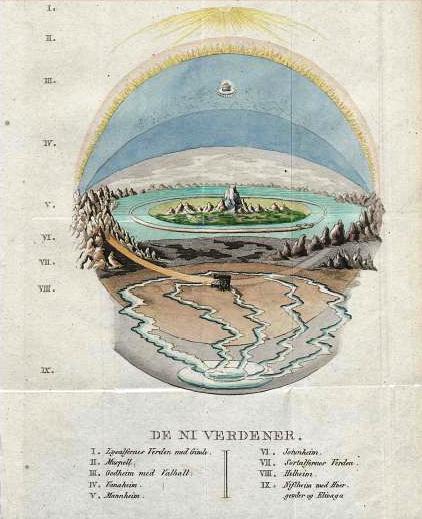 |
||||||||||||||||||||||||||||||||||||||||||||||||||||||||||||||||||||||||||||||||||||||||||||||||||||||||
|
[NORSE
COSMOLOGY] [HOME] |
||||||||||||||||||||||||||||||||||||||||||||||||||||||||||||||||||||||||||||||||||||||||||||||||||||||||
